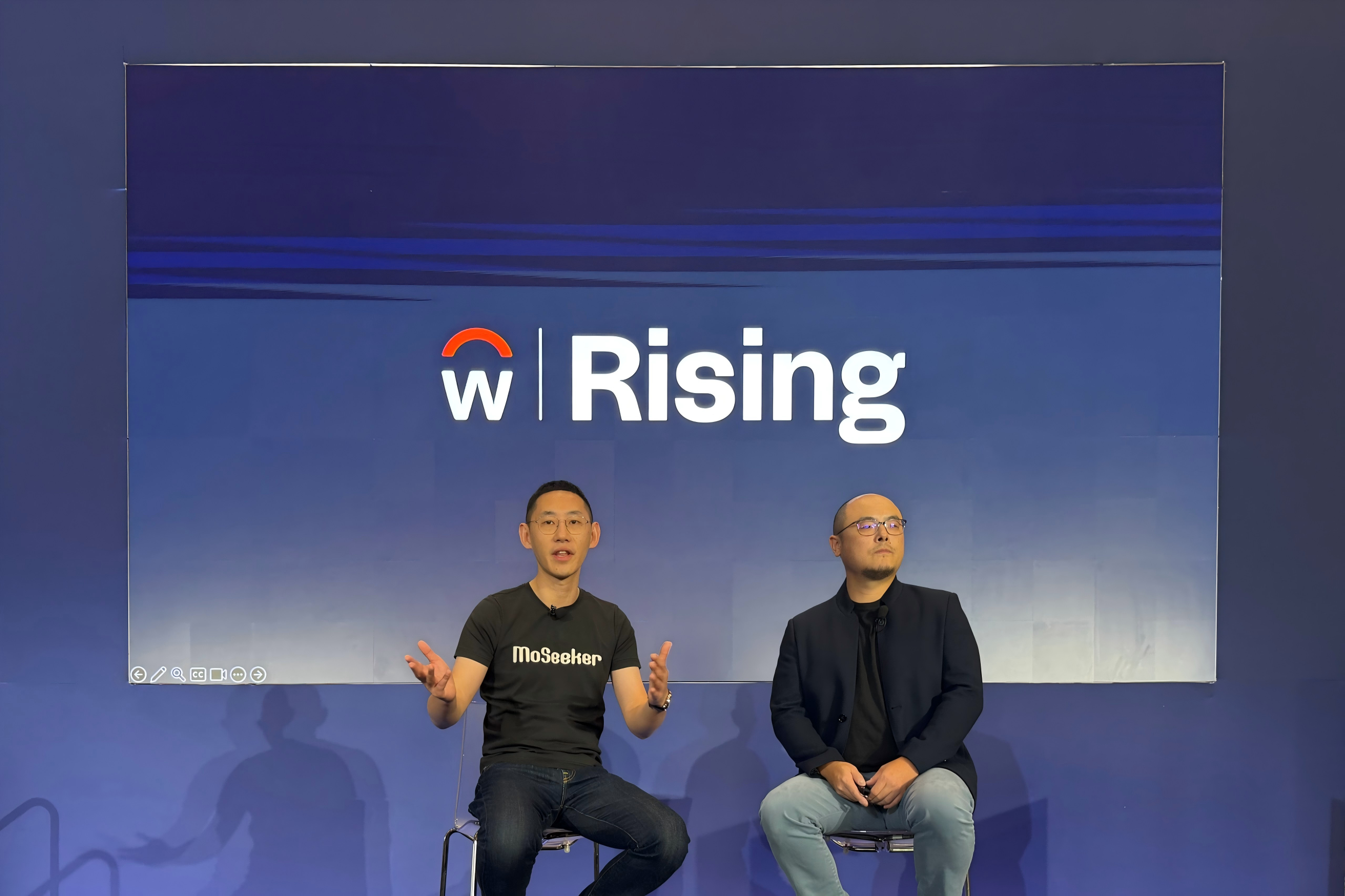On March 17, the MoSeeker 2022 Talent Potential Conference was held in Shanghai, where MoSeeker announced the launch of its Career Social Networking Mini Program on WeChat, marking a strategic shift from a recruitment SaaS platform to a B2B2C model in professional social networking.
Regarding the intention behind this transformation, MoSeeker founder and CEO Wang Xiangdao explained:
“MoSeeker has always been moving forward in empowering recruitment through social networking, but it’s not enough yet. Our B2B SaaS products are already quite mature, and future growth will depend mainly on market capabilities. However, under the current competitive landscape, traditional models make it difficult for companies to achieve another phase of explosive growth with B-end clients. We hope to create synergy between B-end clients and C-end users by building a workplace social network, leveraging C-end network effects to fuel B-side business, and further unlocking the value of social networks in recruitment.”
Since its founding in 2014, MoSeeker has used WeChat as its core scenario for delivering recruitment SaaS services to B-end clients, enabling key features such as social network-based job sharing, internal referrals, and interactive job seeking. In 2018, after securing $15 million in Series B funding from Liepin and Recruit Group, MoSeeker intensified its R&D investment in AI, expanded its product portfolio, and reshaped its business.
To date, in addition to providing MoATS (Applicant Tracking System), MoChannel (automated recruitment synchronization system), and EB employer branding services, MoSeeker has developed a comprehensive intelligent recruitment solution covering AI-powered resume and interview scoring, MoAgent AI voice robot, MoView AI video interview robot, MoPlan AI smart scheduling, and AI-driven candidate-job matching. According to Dr. Tian Ruixiong, MoSeeker’s co-founder and Head of AI Technology, the company also plans to introduce generative AI into its products and services.
This announced shift to a B2B2C model signals that MoSeeker now regards professional social networking as its second growth curve.
However, the road of professional social networking is not easy in China. The debate over whether there is a genuine demand for professional social networking in China has never ceased. As early as nearly twenty years ago, domestic companies such as Tianji, Ruolin, and Renhe began exploring development models for professional social networking sites. At that time, LinkedIn was also grappling with the challenges of user acquisition and revenue generation.
Yet, in stark contrast to the eventual success of professional social networking platforms like LinkedIn in overseas markets, in China, both local platforms and foreign companies attempting to enter the market have repeatedly met with failure. Among them were also traditional recruitment websites that tried to create new professional social functions, only to end up with nothing to show for it. Even LinkedIn China, which had its sights set on conquering the Chinese market, officially announced the closure of its social networking features in 2021.
For companies still determined to make a mark in this sector, figuring out a profitable business model based on professional social networking remains an unsolved challenge. Take Maimai, which has benchmarked itself against LinkedIn: though it achieved user growth on the consumer (C) side by launching features such as workplace reviews, it failed to translate this into the expected revenue growth. This year, Maimai is still seeking new opportunities for value creation and, following the path of Liepin, launched a new brand for mid- to high-end talent recruitment—Maimai Gaopin.
Against this backdrop, whether MoSeeker ’s “reverse” approach will prove effective may depend on its ability to develop a viable path for synergy between its C-end and B-end businesses. Moreover, at this stage, MoSeeker needs to first solve the issues of C-end user acquisition, retention, and activation.
In terms of customer acquisition on the C-end, MoSeeker CEO Wang Xiangdao believes that, first of all, there is a large pool of target users that MoSeeker can reach and operate, judging from the size of the market. He points out:
“Based on MoSeeker’s insights from nine years of recruitment practices on WeChat, there is a large job-seeking population in every vertical sector; these talents are the target users MoSeeker can serve. Shifting from recommending jobs through links such as individual corporate recruitment WeChat public accounts to gathering users through mini-programs not only allows for the provision of diversified job information, but also creates windows for business interaction and workplace networking. We hope that, once target users recognize the value MoSeeker brings to them, they will naturally congregate in our “community,” resulting in a network effect.”
According to reports, the Beta version of the MoSeeker professional social WeChat mini program was launched in July last year, and so far, the number of registered users has reached one million.
Secondly, regarding user acquisition channels, MoSeeker CEO Wang Xiangdao stated that all kinds of future industry conferences, business events, and other scenarios involving serious workplace social interactions are expansion channels that MoSeeker values highly. At the same time, since MoSeeker positioned itself as a recruitment platform powered by social networking from the very beginning, it has accumulated experience in sourcing candidates through social methods, and has developed a basic understanding of target users’ needs and behavioral preferences.
However, it is worth noting that the recruitment service system MoSeeker built based on social networks in the past was still fundamentally rooted in “acquaintance social circles,” making it relatively easier to activate and convert passive job seekers. Yet, the serious professional social scenarios that MoSeeker seeks to develop are largely characterized by “stranger social interactions.” As a result, user retention and activation may prove to be even more challenging—especially given that, at this stage, MoSeeker mainly relies on mini programs to build its professional social network.
Addressing this issue, MoSeeker CEO Wang Xiangdao commented:
“We are still in the early exploratory stage. By using mini programs, users find it easier to get started and can leave whenever they want, which helps ease some psychological burden for C-end users. At this stage, we will continue to enrich the mini program’s functionality, gradually build the ecosystem, create communities, and encourage user interaction. In the future, once we reach a certain scale of users, we will develop a standalone mobile app.”
In addition, from MoSeeker ’s perspective, the key to helping the B-end efficiently acquire talent through a professional social network lies in the appeal of the employer’s brand itself. Since its inception, MoSeeker has targeted large multinational enterprises as its primary clients. At present, it is also expanding its client base to include major state-owned enterprises, including central state-owned enterprises. On one hand, these companies already have strong brand images; on the other hand, through previous collaborations with these clients, MoSeeker has explored employer branding initiatives and achieved tangible results. As a result, CEO Wang Xiangdao believes this will help the company attract active job seekers and retain or activate passive candidates.
Achieving synergy between B-end and C-end businesses requires more than just creating fertile ground for building a professional social network through B-end employer branding services—that’s only one side of the coin. The other side is clarifying how the C-end can, in turn, feed back into and drive B-end business growth.
MoSeeker CEO Wang Xiangdao explained:
“Based on MoSeeker’s nine years of insights into WeChat-based recruitment, the conversion rate from social referrals on WeChat is 20 to 30 times higher than that of typical online recruitment sites. Social networks have already empowered corporate recruitment by increasing efficiency, reducing costs, and shortening hiring cycles, thus creating value for B-end clients. Going forward, by building a professional social network and generating user network effects on the C-end, more professionals will be active on the platform, naturally forming a high-quality talent pool for B-end customers. This will drive the scale growth of B-end clients and promote the growth of related services, such as recruitment SaaS and employer branding consulting.”
In fact, the path that MoSeeker is attempting to explore—gradually expanding into the professional social networking business on the basis of providing SaaS recruitment services through the existing WeChat social network platform—has already been tried by some companies. However, there has yet to be a benchmark case.
Perhaps, as MoSeeker CEO Wang Xiangdao has suggested, the domestic market is beginning to change, and people’s underlying need to separate work from life is being awakened. However, whether MoSeeker and similar companies can ultimately achieve synergy between their B-end and C-end businesses through this approach and successfully evolve into China’s leading professional social networking platform remains to be seen. After all, stimulating latent demand is already difficult enough; the next step will be to explore how to drive sustained B-end business growth while simultaneously meeting the needs of C-end users.
By Shen Xiao
Edited by Wang Yutong
Original Report



